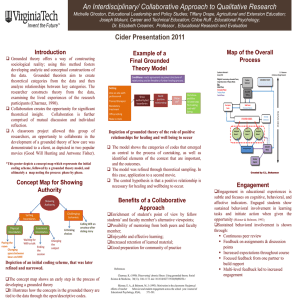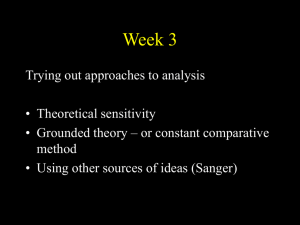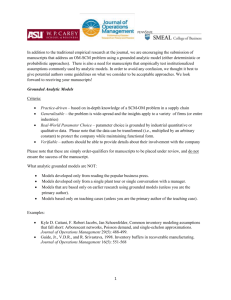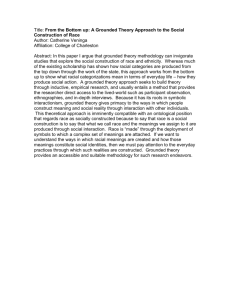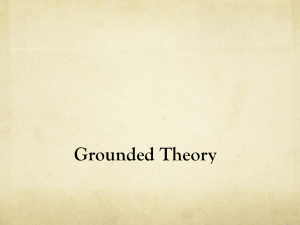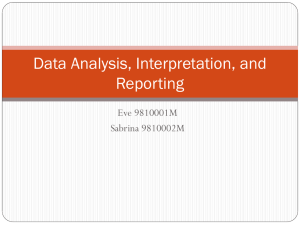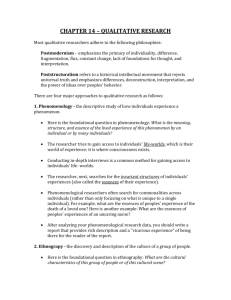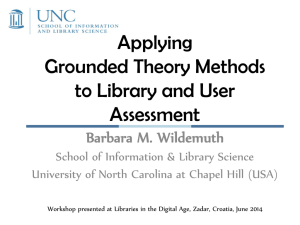What are the characteristics of Grounded Theory?
advertisement
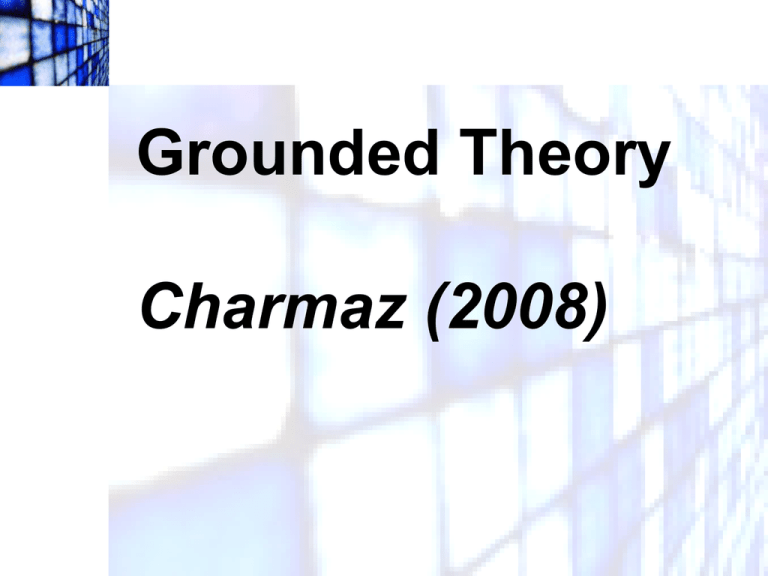
Grounded Theory Charmaz (2008) What is grounded theory? Constructing theory from data. Grounded theory consists of systematic guidelines for gathering, synthesizing, analyzing, and conceptualizing qualitative data to construct theory (Charmaz, 2001). It is an inductive approach to inquiry that begins with data in order to develop an explanatory framework of a phenomenon. What are the characteristics of Grounded Theory? Simultaneous involvement in data collection and analysis Developing analytic codes and categories from the data, not from preconceived hypotheses Constructing middle-range theories to understand and explain behavior What are the characteristics of Grounded Theory? Memo-writing – that is, making analytic notes to explicate and fill out categories Making comparisons between data and data, data and concept, concept and concept What are the characteristics of Grounded Theory? Theoretical sampling – that is, sampling for theory construction to check and refine conceptual categories Delaying the literature review until after forming the analysis What is the goal of Grounded Theory? To construct theory from data. The aim is to produce theories that are truly grounded in the data, theories that do not depend upon external concepts that are brought to the data by the researcher. Hence, The most important basic rule for a grounded theorist is study your emerging data (Glaser, 1978; 1992). What are the versions of Grounded Theory? The positivist version Grounded Theory has a realist orientation. Potential knowledge or objective reality is out there and can be captured by the researcher. Hence, grounded theory can take a positivist approach to knowledge production. What are the versions of Grounded Theory? The social constructionist version Categories cannot simply emerge from the data because they do not exist before the process of categorization. The stress on how people construct actions, meanings, and intentions is in keeping with an interpretive or constructionist tradition. What is a Grounded Theory Research Question? An open-ended question. Initial research question is open-ended and may change in the process. It should not employ constructs derived from existing theories. It often orientates towards action and process. Hence, a “how” question. Procedure for Grounded Theory (Bartlett & Payne, 1997) 1. Collect and transcribe data 2. Develop initial categories – open coding 3. Saturate categories – constant comparison technique 4. Defining categories Procedure for Grounded Theory (Bartlett & Payne, 1997) 5. Theoretical sampling 6. Axial coding 7. Theoretical integration 8. Grounding the theory 9. Filling in the gaps Step-By-Step Grounded Theory 1. Initial Coding 2. Focused Coding 3. Raising Focused Codes to Conceptual Categories 4. Memo-Writing 5. Theoretical Sampling 6. Writing the Draft Step-By-Step Grounded Theory Phase 1: initial coding Coding is the process of defining what the data are about. Do line-by-line coding, naming each line of the data. Use short, specific, active codes that identify what is happening in the data. Phase 1: initial coding Some basic questions may help: What is going on? What are people doing? What is the person saying? What do these actions and statements take for granted? How do structure and context serve to support, maintain, impede, or change these actions and statements? Step-By-Step Grounded Theory Phase 2: focused coding Focused coding means using the most significant and/or frequent earlier codes to sift through large amounts of data. Focused coding is more directed, selective, and conceptual than line-by-line coding. Phase 2: focused coding Link concrete data to more abstract ideas and general processes. Be more interpretative and less descriptive. Coding leads to theoretical categories. Glaser’s two important analytic questions may help: What category or property of a category does this incident indicate? What is this data a study of? Step-By-Step Grounded Theory Phase 3: raising focused codes to conceptual categories First, assess which codes best capture the data. Raise them to conceptual categories for your developing analytic framework. Give them conceptual definitions and treat them in analytical rather than descriptive terms. Phase 3: raising focused codes to conceptual categories A category may subsume common themes and patterns in several codes. Write narrative statements in memos that: (a) explicate the properties of the category, (b) specify the conditions under which the category arises, is maintained, and changes; (c) describe its consequences; and (d) show how this category relates to other categories. Phase 3: raising focused codes to conceptual categories A category may subsume common themes and patterns in several codes. Write narrative statements in memos that: (a) explicate the properties of the category, (b) specify the conditions under which the category arises, is maintained, and changes; (c) describe its consequences; and (d) show how this category relates to other categories. Step-By-Step Grounded Theory Phase 4: memo-writing After defining categories, write memos to elaborate on processes, assumptions, and actions covered by your codes or categories. Phase 4: memo-writing Include the following in your memos: • Define each code or category • Spell out and detail processes subsumed by the codes or categories • Make comparisons between data and between codes and categories • Bring raw data into the memo • Provide empirical evidence for the definition of the category and its analytic claims Step-By-Step Grounded Theory Phase 5: theoretical sampling Collect more data to illuminate theoretical categories. Seek more data to develop and refine categories. Seek negative cases to check the emerging theory. Stop gathering data when you have reached theoretical saturation, that is, no new insight emerges from new data. Step-By-Step Grounded Theory Phase 6: writing the first draft After defining the theoretical categories, supporting them with empirical evidence, and sorting the memos about them, start writing the first draft of the paper. Make an argument for the emerging theory. Provide enough verbatim material to demonstrate the connection between data and theory. Phase 6: writing the first draft Some notes on theoretical integration (Charmaz & Henwood, 2008): • Show how the theory fits together • Explain relationships between theoretical categories or between properties of one category • Specify conditions under which the categories arise • State the consequences of the theorized relationships Grounded Theory Charmaz (2008)
